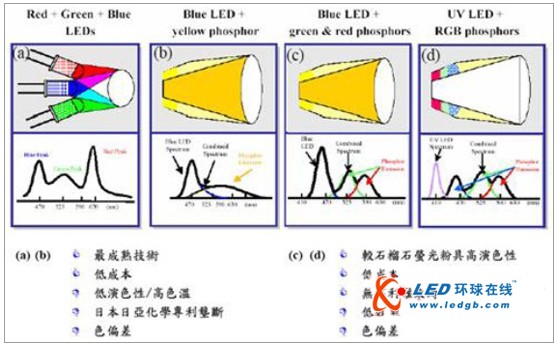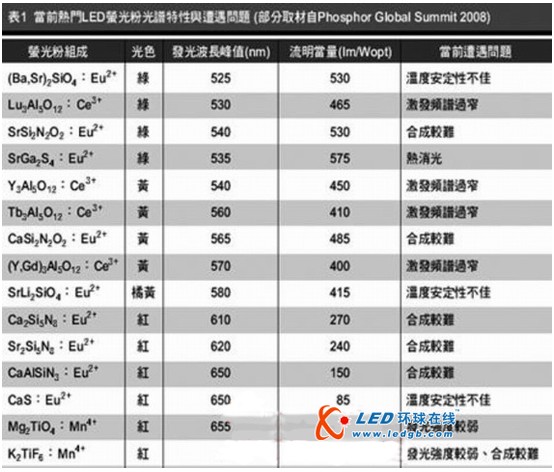The rapid development of commercialization of LED lighting is expected to increase the market demand for white LED phosphors. Under the continuous research and development of phosphors, the three mainstream white LED phosphors that have been developed will be expected to respond. Different applications meet the diversity and stringency requirements of performance.
In order to control global greenhouse gas emissions and save the earth's limited energy resources, in recent years, countries have formulated energy policies and are competing to propose “energy saving and carbon reduction†plans. Among them, incandescent lamps have been announced for the elimination of lighting facilities in Australia, the European Union and California. .
Light-emitting diodes (LEDs) have the advantages of low heat generation, low power consumption, long life, fast response, and small size. At present, the global white LED lighting industry continues to flourish, especially in the backlight of mobile phone panels, lighting and the automotive industry. Applications have more potential. In recent years, many panel manufacturers at home and abroad have introduced white LEDs as backlights for notebook LCDs, replacing traditional cold cathode fluorescent tubes using mercury. From the perspective of solving environmental protection and energy issues, incandescent bulbs have always had low energy efficiency and heat generation. As for mercury-containing fluorescent lamps, there is a disadvantage of mercury pollution. For this reason, LED lighting will undoubtedly become the goal of global lighting manufacturers. Although there are still many problems in the use of white LEDs for Minsheng Lighting, it is expected that in the foreseeable future, under the gradual reduction of manufacturing costs and the development of lighting applications, white LEDs are expected to become highly promising lighting products in the next 10 years.
Since 1993, Nichia Corporation of Japan has successfully developed the world's first commercially commercial blue and violet LEDs based on InGaN, and has accelerated the arrival of white LEDs as a new generation of lighting. Nichia also published a single-chip white LED of InGaN/Y3Al5O12:Ce3+ (YAG:Ce) phosphor in 1996. Since then, the world has been enthusiastically launching a competition for white LED related technology research and development. Nichia has produced a white LED with a luminous efficiency of 150 lumens per watt in 2007. The company also said that the first phase will mass produce a forward current of 20 mA. This LED luminous efficiency is currently the global industry. The highest record.
At present, white LED production technology on the market is mainly divided into two major mainstreams.
The first is to use the phosphor to convert the blue or ultraviolet light generated by the blue LED or the ultraviolet UV-LED into two-dimensional (Dichromatic) or three-color (Trichromatic) white light. This technology is called a phosphor-converted white LED (Phosphor). Converted-LED);
The second type is a multi-chip white LED, which combines two (or more) LEDs of different color lights to form white light. Currently, white LED products are most commonly used in the market, and blue LED chips are most commonly used in automobiles. In the fields of lighting and mobile phone panels, with the current market analysis of white LED products, phosphor-converted white LEDs can be described as mainstream.
Figure 1 below summarizes and compares the various white LED assembly principles and advantages and disadvantages. Among them, (a) is the best in structure and color rendering, but the cost is the highest and has not yet been popularized. The construction method (b) has The most mature technology and low cost, but the color shift and color rendering are not good. It must be improved with appropriate red and yellow phosphors. In addition, the most serious one is the Japanese patent restrictions that are difficult to circumvent; The white LEDs produced by both (d) and (d) have good color rendering, small color, low cost and less serious patent limitations, so they have great potential for development in the future.

Figure 1 Principle and advantages and disadvantages of using white light to generate white light
The performance of the three major white LED phosphors has its own merits
Since the introduction of InGaN/Y3Al5O12:Ce3+ (YAG:Ce) phosphor single-chip white LEDs by Nichia Chemical in 1996, phosphor-converted white LED technology has become the mainstream in the market. The development of phosphors has evolved from less stable sulfides and halides to aluminate, silicate (silicate), nitride (nitride) and nitrogen oxides with better chemical and high temperature stability. Oxynitride) fluorescent materials have recently become the most popular with Nitrix and Oxy-nitride (Table 1).
